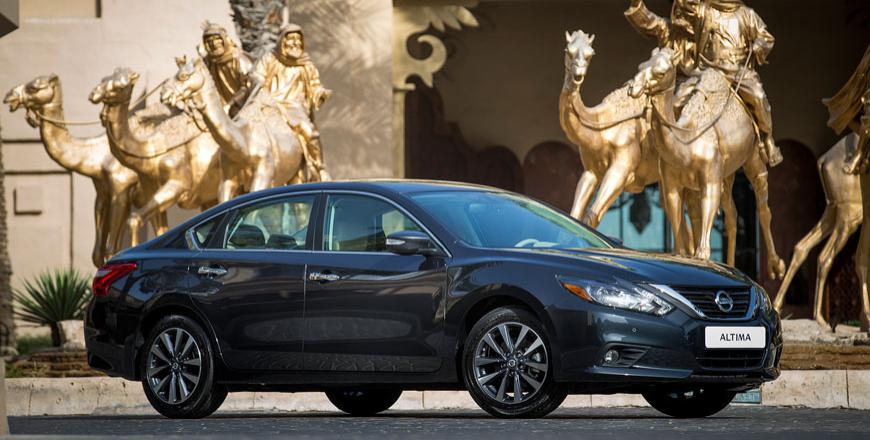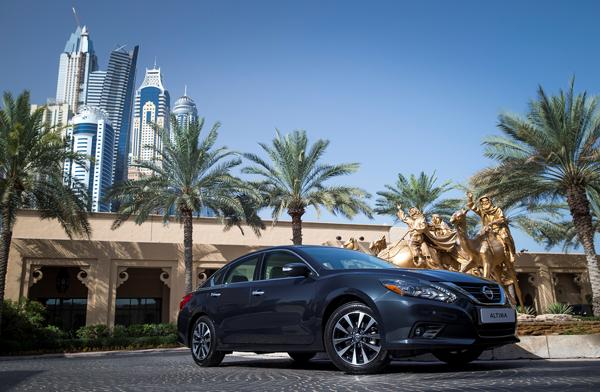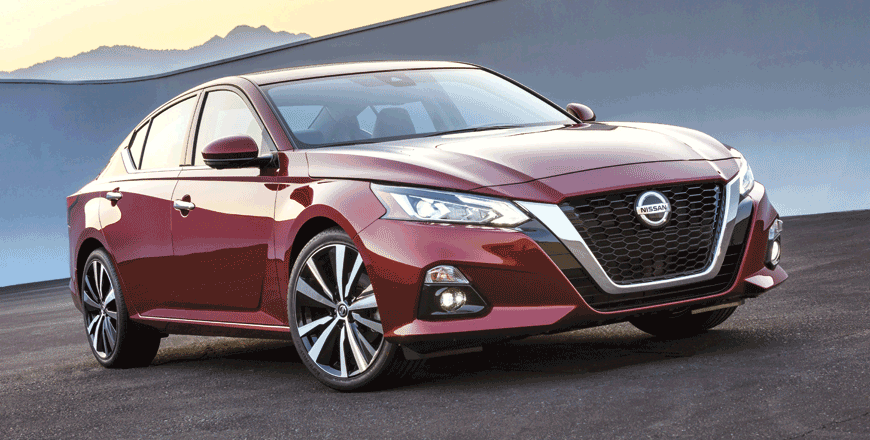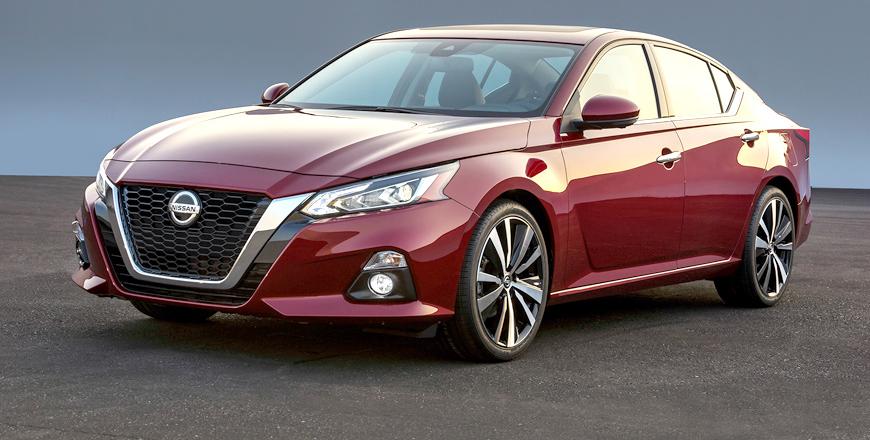You are here
Nissan Altima 3.5 SL: Newfound aggressive aesthetic
By Ghaith Madadha - Jun 06,2016 - Last updated at Jun 06,2016

Photo courtesy of Nissan
Launched regionally in Dubai in tandem with Nissan Middle East’s end of the financial year announcement, the latest incarnation of the Japanese brand’s bread-and-butter D-segment mid-size saloon is a thoroughly face-lifted car with decidedly more aggressive aesthetic treatment, improved chassis settings and more advanced technology suite for 2016.
First launched as a 2013 model, the current generation Altima was noticeably sportier looking for the typically conservative front-wheel drive D-segment. Now revised, the Altima’s chunkier, sharp-edged new aesthetic brings it into line with Nissan’s aggressive new corporate design language first seen on the 2014 Murano crossover, and more recently the Maxima saloon.
Sporting posture
Dubbed Energetic Flow by Nissan, the Altima’s revised styling features a new appearance and part forward of the A-pillars. Complex and somewhat busy but unmistakably assertive and effective in creating a sense of tension and momentum, the Altima’s new front deeper more sculpted intakes and surfacing, angular lines and ridges and sharper lower lip and lights.
Angled narrowly inwards, stretching back and with a sharp peak rising in the middle, the new Altima’s boomerang-like lights flank the brand’s new V-Motion grille design, which not only adorns the Maxima, but has also been grafted onto Nissan’s now long-serving GT-R high performance coupe, for its latest 2017 model year facelift.
More subtly restyled from rear, the revised Altima similarly features boomerang-style rear lights re-sculpted bumper, and dark lower element to accentuate its high, short rear deck and built-in spoiler surfacing. Wavy over its front arches and with flowing, rakishly descending roofline, the face-lifted Altima’s use of active grille shutters, underfloor covers and front and rear fascia, achieves improved aerodynamics.
Eager and progressive
With its similarly aggressive front treatment, size and driveline options, the new Altima blurs the gap between itself and its pricier, sportier and more luxurious Maxima sister. Offered in naturally aspirated 2.5-litre 4-cylinder and 3.5-litre V6-cylinder engines for Middle East markets, the Altima latter range topping V6 is, however, tuned to develop 30HP less than is deployed for the Maxima.
Long-serving, widely used and familiar in different states of tune, the Altima’s all-aluminium VQ-series DOHC 3.5-litre V6 engine is silky smooth, progressive and eager. Producing 270HP at 6400rpm and 258lb/ft in Altima application and driving the front wheels through a smooth and efficient continually variable transmission (CVT), it allows for an estimated 6.1-second sprint through 0-97km/h.
Refined and willing to unleash its power with quick rising increments, the Altima 3.5’s over-square engine is keen to rev to its 6600rpm limit and delivers responsive precise throttle control. Retuned to behave more like an automatic gearbox, the Altima’s CVT transmission feels less elastic in ratio changes than previous, and delivers clearer delineation between simulated pre-set ratios in manual shift mode.
Smooth and reassuring
Noticeably improved and better allowing one to experience the VQ engine’s eager high rev character, one was, however, unable to fully explore the Altima’s re-worked transmission during a short undemanding test drive. Of particular interest is how quick shifting through and committed to pre-set ratios it is during demanding manoeuvring conditions where it would be called upon to make successive and decisive changes.
Riding on MacPherson strut front and independent multi-link rear suspension with front and rear anti-roll bars, the face-lifted Altima’s chassis tweaks include revised dampers, bushes and geometry for improved ride comfort and handling ability and control. Meanwhile, the Altima features equal length half-shafts to reduce the torque steer that is typical of powerful front-wheel drive cars.
Driven on mostly smooth roads and sweeping corners the Altima rode with supple refined comfort and felt stable, settled and reassuring at highway speeds, with decent body control and some lean through corners. With little chance to push closer to its dynamic limits, one found that its retuned power-assisted steering is quick and precise, with somewhat improved road feel, while its driveline was mostly refined.
Comfort and refinement
Fitted with standard Active Understeer Control — which one assumes is a brake-based torque vectoring system — the Altima 3.5 seemed more agile and eager turning in than expected. However, with relatively modest width 215/55R17 tyres and noticeably heavier 62 per cent biased front weighting in the 3.5-litre version compared to the 2.5-litre, one would expect some understeer if pressing hard into a corner.
Benefitting from a more advanced driver assistance suite, the Altima is optionally available with Predictive Forward Collision Warning, radar-based Blind Spot Warning, Forward Emergency Braking, Intelligent Cruise Control and Rear cross Traffic Alert systems. Additionally it features standard ABS brakes, electronic brakeforce distribution and electronic stability and traction control systems.
Refined and well-appointed with comfortable, spacious and well-adjustable front seating, the Altima cabin features user-friendly controls and tasteful design, best in dark rather than light colours as tested. Featuring upgraded infotainment systems, the Altima 3.5 comes with a 7-inch touchscreen, smartphone integration, mobile apps, text message assistance, voice recognition and additional optional smartphone accessible features.
TECHNICAL SPECIFICATIONS
Engine: 3.5-litre, transverse V6 cylinders
Bore x stroke: 95.5 x 81.4mm
Valve-train: 24-valve, DOHC, variable timing
Compression ratio: 10.3:1
Rev limit: 6600rpm
Gearbox: Continuously variable transmission, simulated 7-speed auto, FWD
Gear ratios: 2.413:1–0.383:1
Reverse / final drive: 0.745:1 / 4.602:1
Power, BHP (PS) [kW]: 270 (273) [201] @6400rpm
Torque, lb/ft (Nm): 258 (350) @4400rpm
0-97km/h: 6.1 seconds (est.)
Top speed: 210km/h (est.)
Fuel consumption, city/highway/combined: 10.7-/7.35-/9 litres/100km* *US EPA
Fuel capacity: 68 litres
Length: 4,879mm
Width: 1,830mm
Height: 1,471mm
Wheelbase: 2,776mm
Track: 1,575mm
Aerodynamic drag co-efficient: 0.28
Headroom, F/R: 1,016/942mm
Legroom, F/R: 1,143/916mm
Hip room, F/R: 1,371/1,323mm
Shoulder room, F/R: 1432/1432mm
Boot volume: 517 litres
Kerb weight: 1,530-1,570kg
Weight distribution, (%) F/R: 62/38
Suspension, F/R: MacPherson struts / multi-link
Steering: Power-assisted, rack & pinion
Turning circle: 11.4 metres
Lock-to-lock: 2.8 turns
Brakes, F/R: Ventilated discs, 297 x 26mm / discs, 292 x 9mm
Tyres: 215/55R17
Related Articles
First introduced in 2013 and now thoroughly redesigned and enhanced for 2016, the new Nissan Altima, brings an assertive new corporate desig
Launched in 2018, the sixth generation Nissan Altima is the most technologically advanced incarnation of the Japanese manufacturer’s popular
A venerable and attainable mid-size middle of the road family saloon that performed well on so many levels, if not necessarily the best on e

















